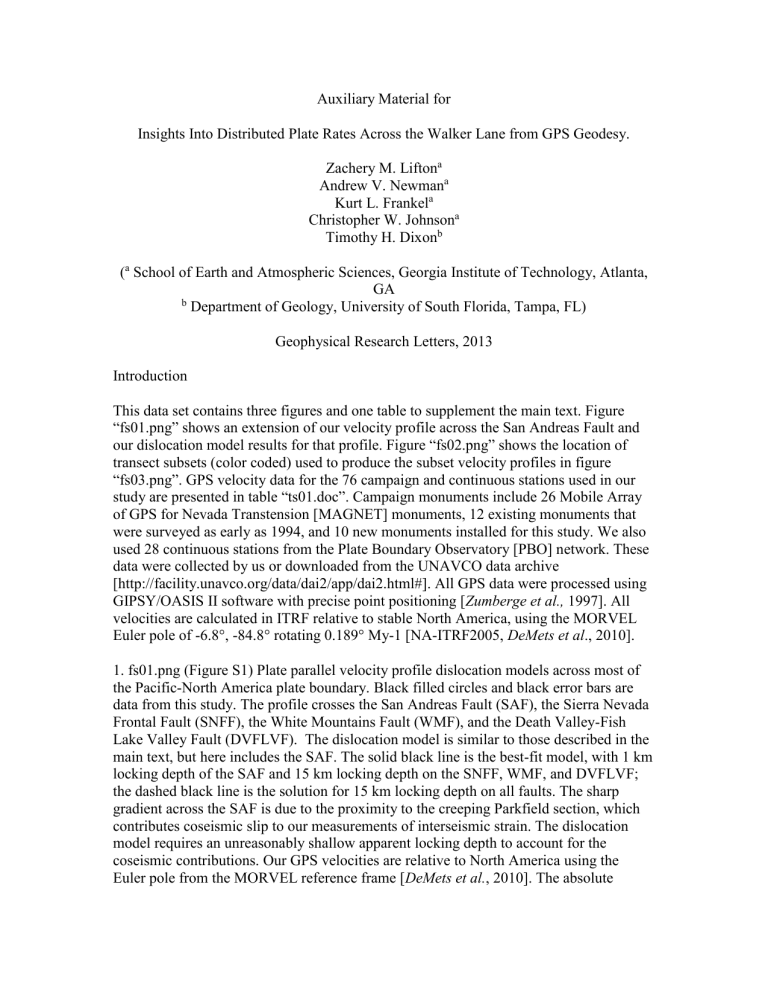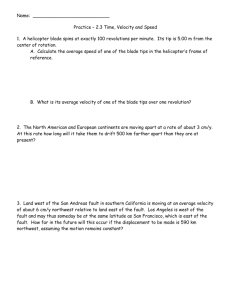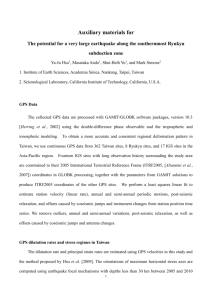Lifton_etal_GPS_suppl_readme_rev1

Auxiliary Material for
Insights Into Distributed Plate Rates Across the Walker Lane from GPS Geodesy.
Zachery M. Lifton a
Andrew V. Newman a
Kurt L. Frankel a
Christopher W. Johnson a
Timothy H. Dixon b
( a
School of Earth and Atmospheric Sciences, Georgia Institute of Technology, Atlanta,
GA b Department of Geology, University of South Florida, Tampa, FL)
Geophysical Research Letters, 2013
Introduction
This data set contains three figures and one table to supplement the main text. Figure
“fs01.png” shows an extension of our velocity profile across the San Andreas Fault and our dislocation model results for that profile. Figure “fs02.png” shows the location of transect subsets (color coded) used to produce the subset velocity profiles in figure
“fs03.png”. GPS velocity data for the 76 campaign and continuous stations used in our study are presented in table “ts01.doc”. Campaign monuments include 26 Mobile Array of GPS for Nevada Transtension [MAGNET] monuments, 12 existing monuments that were surveyed as early as 1994, and 10 new monuments installed for this study. We also used 28 continuous stations from the Plate Boundary Observatory [PBO] network. These data were collected by us or downloaded from the UNAVCO data archive
[http://facility.unavco.org/data/dai2/app/dai2.html#]. All GPS data were processed using
GIPSY/OASIS II software with precise point positioning [ Zumberge et al., 1997]. All velocities are calculated in ITRF relative to stable North America, using the MORVEL
Euler pole of -6.8°, -84.8° rotating 0.189° My-1 [NA-ITRF2005, DeMets et al ., 2010].
1. fs01.png (Figure S1) Plate parallel velocity profile dislocation models across most of the Pacific-North America plate boundary. Black filled circles and black error bars are data from this study. The profile crosses the San Andreas Fault (SAF), the Sierra Nevada
Frontal Fault (SNFF), the White Mountains Fault (WMF), and the Death Valley-Fish
Lake Valley Fault (DVFLVF). The dislocation model is similar to those described in the main text, but here includes the SAF. The solid black line is the best-fit model, with 1 km locking depth of the SAF and 15 km locking depth on the SNFF, WMF, and DVFLVF; the dashed black line is the solution for 15 km locking depth on all faults. The sharp gradient across the SAF is due to the proximity to the creeping Parkfield section, which contributes coseismic slip to our measurements of interseismic strain. The dislocation model requires an unreasonably shallow apparent locking depth to account for the coseismic contributions. Our GPS velocities are relative to North America using the
Euler pole from the MORVEL reference frame [ DeMets et al.
, 2010]. The absolute
amplitude of the displacement field will be shifted ~0.5 mm/yr to the southeast if we use the GEODVEL reference frame [ Argus et al.
, 2010]. For comparison, we also show profile #4 from McCaffrey [2005] (gray filled circles, gray error bars, and gray curve).
McCaffrey
’s [2005] profile crosses the plate boundary further south, at ~36°N, and shows deformation spread over a wider region and a less distinct plateau of velocities across the
Sierra Nevada block.
2. fs02.png (Figure S2) Walker Lane GPS velocity field with sited colored by transect.
Colors correspond to profiles in Fig. S3. CVF – Clayton Valley Fault; DV-FLVF – Death
Valley-Fish Lake Valley Fault; EIF – Eastern Inyo Fault; EPF – Emigrant Peak Fault;
LMF – Lone Mountain Fault; LVC – Long Valley Caldera; SNFF – Sierra Nevada
Frontal Fault; SPLM – Silver Peak-Lone Mountain extensional complex; WMF – White
Mountains Fault.
3. fs03.png (Figure S3) Additional plate-parallel and plate-normal velocity profiles along transects perpendicular to plate motion. (C) and (D) are duplicated from Fig. 2 and are included here for completeness. Circle colors correspond to circle colors on Fig. S2. DV-
FLVF – Death Valley-Fish Lake Valley Fault; EIF – Eastern Inyo Fault; LVC – Long
Valley Caldera; SNFF – Sierra Nevada Frontal Fault; SPLM – Silver Peak-Lone
Mountain extensional complex; WMF – White Mountains Fault.
4. ts01.doc GPS station positions and velocities.
4.1 Column “Station ID”, four letter station name.
4.2 Column “Longitude”, degrees, longitude of station.
4.3 Column “Latitude”, degrees, latitude of station.
4.4 Column “Elevation”, meters, elevation above mean sea level of station.
4.5 Column “Velocity East”, mm/year, east component of station velocity.
4.6 Column “Velocity North”, mm/year, north component of station velocity.
4.7 Column “Uncertainty East”, mm/year, uncertainty in east component of station velocity.
4.8 Column “Uncertainty North”, mm/year, uncertainty in north component of station velocity.
4.9 Column “Years Occupied”, years in which station was occupied.
References:
Argus, D. F., R. G. Gordon, M. B. Heflin, C. Ma, R. J. Eanes, P. Willis, W. R. Peltier, and S. E Owen. (2010). The angular velocities of the plates and the velocity of
Earth's centre from space geodesy. Geophysical Journal International, 180(3),
913–960. doi:10.1111/j.1365-246X.2009.04463.x.
DeMets, C., R. G. Gordon, and D. F. Argus (2010), Geologically current plate motions,
Geophysical Journal International, 181(1), 1–80, doi:10.1111/j.1365-
246X.2009.04491.x.
McCaffrey, R. (2005). Block kinematics of the Pacific–North America plate boundary in the southwestern United States from inversion of GPS, seismological, and geologic data. Journal of Geophysical Research , 110 (B7), B07401. doi:10.1029/2004JB003307.
Zumberge, J., Heflin, M., Jefferson, D., Watkins, M., & Webb, F. (1997). Precise point positioning for the efficient and robust analysis of GPS data from large networks.
Journal of Geophysical Research , 102 , 5005–5018.









